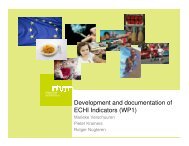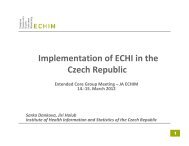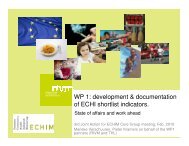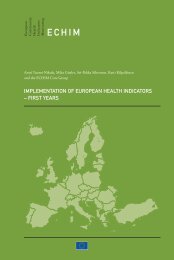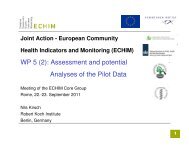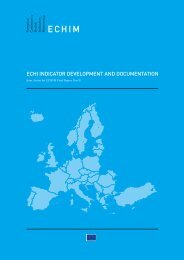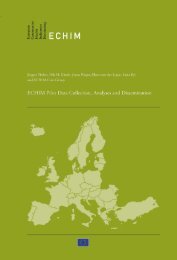INDICATORS
ECHIM Final Report
ECHIM Final Report
You also want an ePaper? Increase the reach of your titles
YUMPU automatically turns print PDFs into web optimized ePapers that Google loves.
Jürgen Thelen, Ari-Pekka Sihvonen, Antti Tuomi-Nikula<br />
4. AVAILABILITY OF ECHI <strong>INDICATORS</strong><br />
4.1. Identifying the international data sources<br />
One of the main objectives of the ECHIM project was to assess the availability and<br />
comparability of the ECHI shortlist indicators in the EU Member States, Candidate<br />
Countries and EEA/EFTA countries. This was considered necessary because until the<br />
launch of the ECHIM project, information about the actual availability of the proposed<br />
ECHI shortlist indicators was incomplete and outdated. For this reason it was decided<br />
to compile “Country Reports” using the data already available for the ECHI shortlist<br />
indicators. For organisational reasons, the ECHI shortlist indicators were initially<br />
divided into three sections. The first section contained the indicators that had previously<br />
been assessed as regularly available and comparable. The second section contained those<br />
indicators where data availability and comparability was assessed as limited. The third<br />
section consisted of those indicators that had been assessed as not available or not<br />
comparable. In addition, there was the list of indicators, which had been proposed by<br />
projects and Working Parties after the ECHI shortlist indicators had been selected.<br />
Because the data for the different indicators were not available in a single database, it<br />
was decided to use all major international databases for the availability check. Many<br />
of the ECHI shortlist indicators were provided by more than one database. For those<br />
indicators the data from the different databases were compiled into one Excel file in<br />
order to give the national contact persons an overview of the data their country provides<br />
for the various international organisations.<br />
In addition to the data retrieved from international databases, project-based databases<br />
were included in the review. This was felt appropriate as several projects that dealt with<br />
the development of health indicators under the DG SANCO Public Health Programme<br />
had established topic-specific databases. These databases normally covered indicator sets<br />
for theme-specific purposes, e.g. the monitoring of mental health (MINDFUL project)<br />
or environmental health (ENHIS project), and contained data from pilot data collections<br />
under these projects. It is important to account for the fact that the future development<br />
of these databases is currently unclear. For this reason, indicator data contained in these<br />
databases was only presented if there was no other data source. Usually these project<br />
databases were designed as comprehensive “user windows” that contained indicators<br />
from both the ECHI shortlist and the longlist.<br />
48



